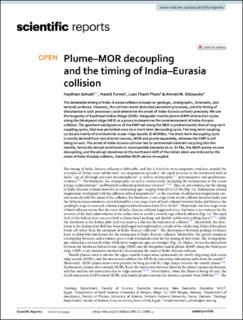Plume–MOR decoupling and the timing of India–Eurasia collision
Journal article, Peer reviewed
Published version

Åpne
Permanent lenke
https://hdl.handle.net/11250/3054246Utgivelsesdato
2022Metadata
Vis full innførselSamlinger
- Department of Earth Science [1034]
- Registrations from Cristin [9489]
Sammendrag
The debatable timing of India–Eurasia collision is based on geologic, stratigraphic, kinematic, and tectonic evidence. However, the collision event disturbed persistent processes, and the timing of disturbance in such processes could determine the onset of India–Eurasia collision precisely. We use the longevity of Southeast Indian Ridge (SEIR)—Kerguelen mantle plume (KMP) interaction cycles along the Ninetyeast ridge (NER) as a proxy to determine the commencement of India–Eurasia collision. The geochemical signature of the KMP tail along the NER is predominantly that of long-term coupling cycles, that was perturbed once by a short-term decoupling cycle. The long-term coupling cycles are mainly of enriched mid-ocean ridge basalts (E-MORBs). The short-term decoupling cycle is mostly derived from two distinct sources, MOR and plume separately, whereas the KMP is still being on-axis. The onset of India–Eurasia collision led to continental materials recycling into the mantle; hence the abrupt enrichment in incompatible elements at ca. 55 Ma, the MOR–plume on-axis decoupling, and the abrupt slowdown in the northward drift of the Indian plate was induced by the onset of India–Eurasia collision, thereafter MOR–plume recoupled.
